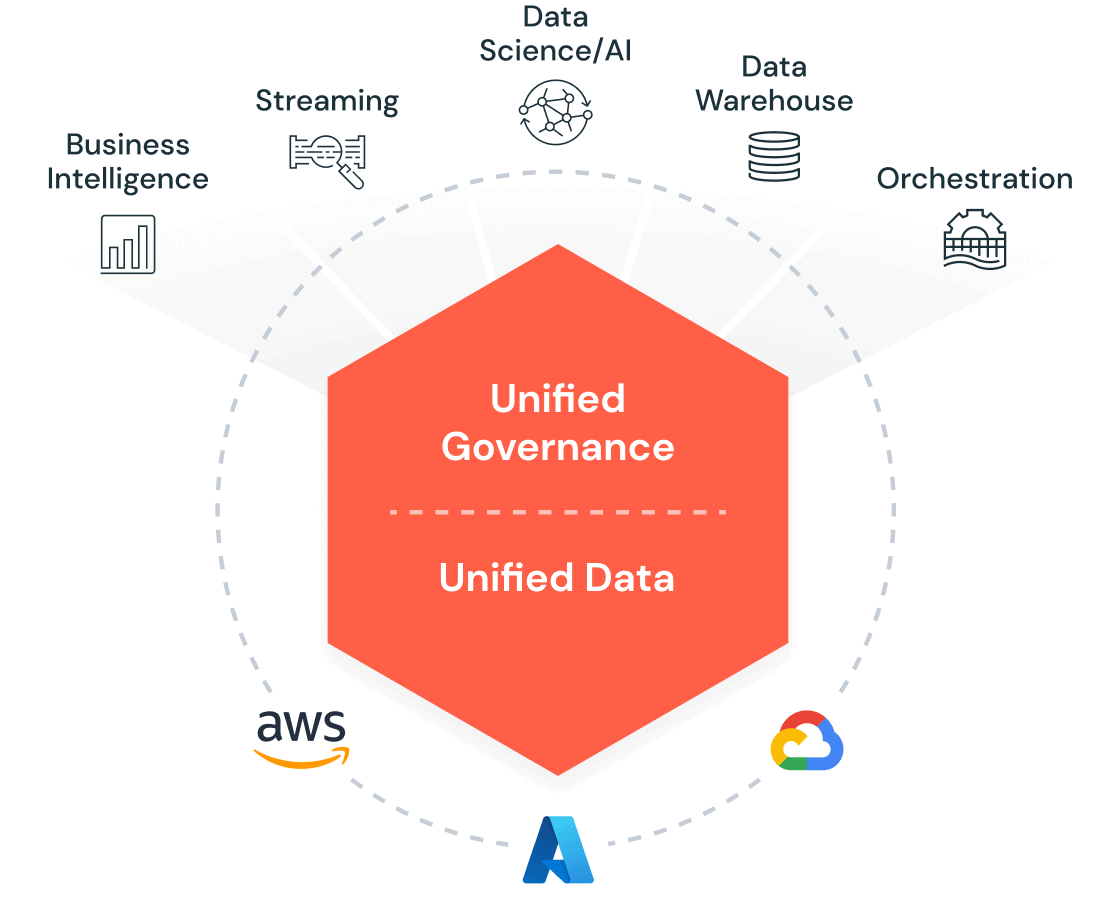Marketing has entered the ‘data-driven’ age.
Businesses of all sizes can now collect information on their customers and use it to improve their campaigns.
With the power of big data analytics, marketers can create ads that are more targeted and more engaging than ever before. It’s also easier to track performance indicators and make changes when campaigns don’t deliver as expected. When implemented successfully, big data is like a cheat code for marketers, resulting in higher ROI, sales, and business growth.
However, with these new opportunities come new challenges, and one major one is data silos.
In fact, a global study conducted by Forrester Consulting on behalf of Airtable found that a whopping 79% of knowledge workers reported their company had issues with teams being siloed. They also had to spend nearly 12 hours a week looking for the right information!
Data silos like this can pose a problem where marketers can accidentally rely on outdated or irrelevant data — leading you to the wrong conclusions and undoing all of your hard work.
So, let’s look at what marketing silos are and the reasons they exist. Then, we’ll show you the types of data management tools you can use to prevent them in the first place.
 Free to use image from Unsplash
Free to use image from Unsplash
What is a Marketing Data Silo?
A data silo is akin to a physical silo on a farm — it’s a repository that stands alone, disconnected from others. In a marketing context, data silos occur when information is collected by different departments (or software applications) within a company, but is not shared or integrated with the rest of the organization.
This lack of integration leads to a fragmented understanding of customers and markets, as each department only sees a part of the whole picture. Just as silos on a farm keep different grains separate and isolated, marketing data silos keep valuable insights locked away, often leading to duplicated efforts and missed opportunities for synergy and growth.
What Causes Data Silos?
Silos are formed when barriers exist in the collection of data — either due to operational problems in software or human oversight. Two common reasons are:
Unintegrated data sources
A data silo may form when your company has multiple data sources that don’t connect to a central point. When each source’s data is stored in a different location, and these locations are unconnected, it’s easy for multiple, uncoordinated systems to spring up.
For instance, if different departments use separate tools for customer relationship management, sales tracking, and social media analytics, vital information gets trapped in isolated pockets. Technologies like Hadoop clusters, designed to handle large sets of data across distributed computing environments, can sometimes contribute to this issue if not properly integrated with the company’s main data management systems.
Silo mentality
Often, marketing silos are caused by the company culture itself. This is especially the case when departments — such as sales, marketing, and product teams — fail to communicate with one another. If the branches of your business are disconnected then you’ll have almost no chance of forming a coherent strategy toward data storage, handling, and usage.
This issue can hugely hinder social media marketing, where rapid, dynamic data generation requires constant communication and data sharing across business departments. A siloed approach here can lead to off-brand customer messaging or missed opportunities for cross-promotion, for example.

Free to use image from Unsplash
The Negative Impact of Data Silos on Marketing Efficiency
Is it really that bad if your marketing and sales teams have access to different sets of information?
Unfortunately, the answer is yes! It might seem like a minor detail, but it can quickly escalate into a major problem. Consider these downsides of data silos and how they might affect your brand’s outcomes later down the line:
- Inconsistent customer experience: If different teams have different information, your customers might get mixed messages. You never want your customers to feel confused, as they won’t trust your business enough to make a purchase decision.
- Wasted time and resources: Your teams might be spending hours gathering the same data from different places. There’s no point duplicating something you already have – it’s time that could be spent more productively on thinking up creative marketing ideas or engaging directly with customers.
- Difficulty in measuring campaign success: If your data isn’t all in one place, it’s hard to get a clear picture of how well your marketing campaigns are doing. You might not know what’s working and what’s not.
- Boring ad campaigns: Data silos make it hard to try new marketing approaches. If you don’t have a full view of your data, it’s tough to be innovative and stay ahead of the competition. Plus, you might make the wrong choices – for instance, your customer service team might have an idea of common customer complaints about competitors.If that’s not shared with your marketing team, you might make the same mistakes.
- Missed opportunities: When your data is scattered, you might miss out on important customer insights. You might be missing out on the latest social media marketing trends that your competitors are already using!
How to Combat Data Silos: 5 Key Strategies
To effectively tackle data silos, you must adopt a two-pronged approach: integrating your data collection methods and fostering a culture of collaboration and open communication. We’ll explain how you can ensure this (and the tools you should use) in a step-by-step guide:
Identify where your data is currently located
The first step in combating data silos is to actually understand where your data resides. This can be a monumental task if your business relies on multiple apps and storage databases. Here are some of the most common locations where data might be stored:
- CRM systems. Customer information is often stored in customer relationship management systems. To streamline customer service operations and ensure seamless data integration across various touchpoints, businesses can leverage service cloud implementation services that help consolidate customer information from multiple sources into a unified platform, enabling more efficient and personalized support experiences. These CRMs keep records of all customer interactions — things like contact details, purchase history, and customer service chat logs — which is a goldmine for your sales and marketing teams. However, if it’s not integrated with other systems, it can lead to a narrow view of the customer.
- ERP systems. Enterprise resource planning software provides a wide range of operational data. It keeps records on everything from inventory levels and supply chain forecasts to financial data like sales figures and expense reports. For security reasons, this sort of data is usually restricted to upper-level management figures.
- Email/SMS. Email and SMS platforms can be treasure troves of direct communication with customers, including inquiries, feedback, and negotiation histories. These sorts of conversations are extremely useful for creating ‘customer personas’, but are sadly often overlooked in the broader data strategy of a business.
- Marketing platforms. Tools like Google Analytics hold marketing campaign data and customer engagement statistics. This information is instrumental not only for finding high ROI marketing strategies, but also for optimizing them via A/B testing.
- Cloud storage services: Collaborative platforms are often used for storing internal documents. However, data can easily become siloed if some departments have access to repositories that others don’t, for example. Even so, it’s essential to understand data management on the cloud. This can be done by gaining knowledge from certification studies, such as DP-203 Exam Dumps. This knowledge will help you in creating more efficient data storage solutions.
- Social media: Customer feedback and interaction data is also present on platforms like Facebook or Instagram— whether you manually respond to queries or use social media automation. This is often the most up-to-date source of information on everything from your new product launches to customer complaints.
- Legacy databases: Old hard drives and servers might contain historical data that’s simply been forgotten about! By uploading them to the cloud you can enable easy sharing and collaboration, rather than relying on outdated software or physical access.

Free to use image from Unsplash
Adopt the right tech stack
If you’ve struggled with isolated data pools, a holistic approach to data integration is your key to success. Luckily, this task is much easier when you have tools that automatically share data to the right locations and with the right people. Here’s a list of technologies that can help:
- Data integration platforms. To avoid data silos, you need to pull fragmented data from multiple sources — CRM, ERP, and others — and compile it into a unified repository. For this, you’ll need a data integration tool capable of performing ETL functions (Extract, Transform, Load) to convert data into a consistent format.
- API management tools. For data in hard-to-reach places, API management tools are essential. These tools complement data integration platforms by ensuring that the data not only gets centralized but also remains accessible and functional across different applications and services.
- Cloud storage solutions. There are two main ways to approach cloud storage. One is to keep everything internal, with a private cloud being hosted in your very own secure server room. This requires a lot of investment and technical know-how, however. For a more flexible option, you can use infrastructure-as-a-service storage solutions. These make it easy to scale your data storage needs when you need to, and not over-pay in the meantime. To ensure cost-effectiveness, businesses can implement cloud cost optimization strategies, helping to maximize resources while minimizing unnecessary expenses. In addition, using IPAM solutions can help manage your network more efficiently as your storage needs expand, ensuring resources are allocated properly.
- Data lakehouses. Of course, you can’t just dump all of your data into one location and expect to be done with it. While solutions like RDDs (RDD meaning Resilient Distributed Dataset) are an option for small scale operations, you likely need something capable of handling large amounts of data and keeping it organized. Data lakehouses combine data storage, governance, integration, processing, and analytics all in one location. This makes it easy for everyone to reference one central data source, and gather insights at the same time.

Image from Databricks
3. Maintain the quality of your data storage structures
Maintaining the quality of your marketing data is crucial to get the most out of it. It’s like keeping your car in top shape — regular checks and maintenance are key to keeping it running smoothly. Here’s how you can keep your data storage structures in prime condition:
- Implement a data governance framework. Your first task is to develop a data governance framework that outlines who has access to what data and how it can be used by them. Make sure the right people have the right access; otherwise, your data’s potential remains locked away, just as it would in silos!
- Keep things secure. Merging data from different sources introduces new cybersecurity challenges, as you could be opening gaps for threats to slip through. Implementing cloud security validation processes ensures that your integrated data systems remain protected against vulnerabilities. A good starting point is to turn on automatic updates for your tech stack’s security patches, and to train your team on robust cybersecurity practices.
- Perform regular audits. During an audit, you’re essentially double-checking your data’s accuracy and relevance. Things to watch out for are incomplete, corrupted, or duplicated data — which would obviously throw a spanner in the works if you want to rely on it for marketing insights.
- Ensure regulatory compliance. No matter how you intend to use or store data, you must always stay on the right side of the law. For example, laws like GDPR in Europe or CCPA in California dictate how you should operate in their jurisdictions. Whether it’s obtaining consent from customers before collecting their data, or providing them with the right to access and delete their personal info, failure to follow these rules can result in severe penalties.
4. Foster a collaborative culture in your workplace
It’s pointless to integrate your data if your team (the people meant to be using it!) remain disconnected. Beyond basic training, you may want to implement these tips to create a collective sense of responsibility in the handling of data:
- Encourage open communication.Firstly, you should promote an open-door policy where team members feel comfortable sharing information and asking questions. For example, imagine your marketing team launches a new campaign and gathers valuable customer feedback. By openly sharing this data with the product development team, they can adjust their strategies or improve products based on real customer insights. The best way to create this culture of transparency and trust is for management to lead by example!
- Use collaboration platforms. Even if your business hasn’t adopted hybrid working yet, you can still benefit massively from using a virtual communication platform. It’s faster and less formal than sending an email, which means your teams are more likely to keep in sync and hop in calls where necessary to help each other out. Let’s say your sales team spots a sudden dip in customer preference for a product — they can easily open a line to the marketing team to double-check if any mistakes were made on a product’s info page, for example.
- Organize regular team meetings. Be sure to schedule regular get-togethers where teams can come together to discuss ongoing projects and share data insights. You could also host virtual brainstorming sessions to bring in new perspectives for your business’s data silo problems.

Free to use image from Unsplash
5. Hire experts or consider outsourcing
If you’re scratching your head at this, don’t worry — data handling is indeed tough! It’s often expensive, time-consuming, and requires a level of technical expertise that may not be available in all businesses. There’s absolutely no shame in acknowledging that some or all of this process might be better managed with a bit of help: such as bringing in external experts or outsourcing the bulk of the task.
A hybrid approach to data management is often the most effective. That way, you can retain control over top-level data management tasks while outsourcing the technical parts. This allows your in-house team to focus on more strategic tasks like planning your next marketing campaign and imagining how it’ll resonate with your audience.
For instance, you could use call center outsourcing services to streamline customer data integration and management. These services provide you with market research in the form of direct feedback, which you can use to build detailed customer personas and engagement strategies.
Conclusion: Toward a Unified Data Strategy
Conquering data silos is just as much about bringing your team together as it is about unifying your data sources. It’s a bit like hosting a big group bonding session for your business departments, and then giving them the data governance framework to work effectively together.
It’s important to remember that creating a data strategy is not a one-time event. Every piece of the puzzle — whether it’s a tool, a team member, or a process — is essential to create the entire picture of your business. As soon as data becomes outdated or lost, everything falls apart.
Your aim should be to create an automated system that provides real-time updates on market conditions and customer behavior. With access to this information, your marketers will have the power to create campaigns that never miss!


